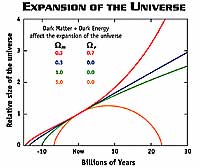
What is the Ultimate Fate of the Universe?
Just as Robert Frost imagined two possible fates for the Earth in his poem, cosmologists envision two possible fates for the universe:
- Endless expansion
- The “Big Crunch”
 The evolution of the universe is determined by a struggle between the momentum of expansion and the pull (or push!) of gravity. The current rate of expansion is measured by the Hubble Constant, while the strength of gravity depends on the density and pressure of the matter in the universe. If the pressure of the matter is low, as is the case with most forms of matter we know of, then the fate of the universe is governed by the density.
The evolution of the universe is determined by a struggle between the momentum of expansion and the pull (or push!) of gravity. The current rate of expansion is measured by the Hubble Constant, while the strength of gravity depends on the density and pressure of the matter in the universe. If the pressure of the matter is low, as is the case with most forms of matter we know of, then the fate of the universe is governed by the density.
If the density of the universe is less than the critical density, then the universe will expand forever, like the green or blue curves in the graph above. Gravity might slow the expansion rate down over time, but for densities below the critical density, there isn’t enough gravitational pull from the material to ever stop or reverse the outward expansion. This is also known as the “Big Chill” or “Big Freeze” because the universe will slowly cool as it expands until eventually it is unable to sustain any life.
If the density of the universe is greater than the critical density, then gravity will eventually win and the universe will collapse back on itself, the so called “Big Crunch”, like the graph's orange curve. In this universe, there is sufficient mass in the universe to slow the expansion to a stop, and then eventually reverse it.
Recent observations of distant supernova have suggested that the expansion of the universe is actually accelerating or speeding up, like the graph's red curve, which implies the existence of a form of matter with a strong negative pressure, such as the cosmological constant. This strange form of matter is also sometimes referred to as the “dark energy”. Unlike gravity which works to slow the expansion down, dark energy works to speed the expansion up. If dark energy in fact plays a significant role in the evolution of the universe, then in all likelihood the universe will continue to expand forever.
There is a growing consensus among cosmologists that the total density of matter is equal to the critical density, so that the universe is spatially flat. Approximately 24% of this is in the form of a low pressure matter, most of which is thought to be “non-baryonic” dark matter, while the remaining 71% is thought to be in the form of a negative pressure “dark energy”, like the cosmological constant. If this is true, then dark energy is the major driving force behind the fate of the universe and it will expand forever exponentially.
Measurements from WMAP
The WMAP satellite measures the basic parameters of the Big Bang theory including the fate of the universe. The results suggest the geometry of the universe is flat and will expand forever. Further study of the dark energy with future experiments and space missions is needed to understand its nature and effect on the rate of future expanison.
Other Interesting Sites:
On cosmology with supernovae:
- The Supernova Cosmology Project: the LBL program to measure the expansion history.
- The High-Z Supernova Search: the multi-national program to measure the expansion history.
- The SNAP mission: a proposed satellite mission to study cosmology with supernovae.
On runaway expansion:
- The fate of the contents of the universe is described in a nice timeline from the NOVA show The Runaway Universe.

